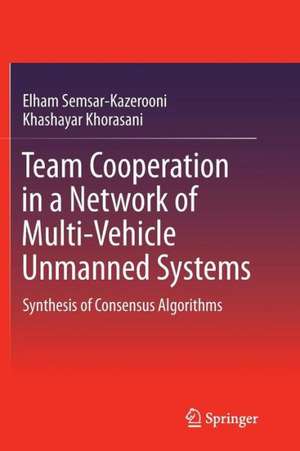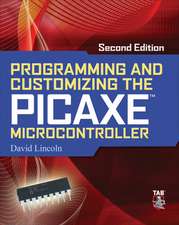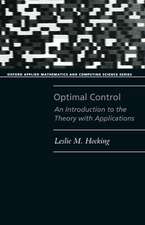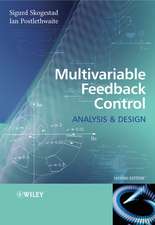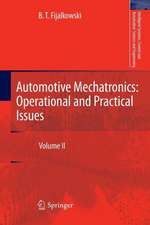Team Cooperation in a Network of Multi-Vehicle Unmanned Systems: Synthesis of Consensus Algorithms
Autor Elham Semsar-Kazerooni, Khashayar Khorasanien Limba Engleză Paperback – 13 dec 2014
| Toate formatele și edițiile | Preț | Express |
|---|---|---|
| Paperback (1) | 634.49 lei 43-57 zile | |
| Springer – 13 dec 2014 | 634.49 lei 43-57 zile | |
| Hardback (1) | 639.25 lei 43-57 zile | |
| Springer – 21 noi 2012 | 639.25 lei 43-57 zile |
Preț: 634.49 lei
Preț vechi: 746.47 lei
-15% Nou
Puncte Express: 952
Preț estimativ în valută:
121.45€ • 131.96$ • 102.08£
121.45€ • 131.96$ • 102.08£
Carte tipărită la comandă
Livrare economică 21 aprilie-05 mai
Preluare comenzi: 021 569.72.76
Specificații
ISBN-13: 9781489987198
ISBN-10: 1489987193
Pagini: 176
Ilustrații: XXIV, 152 p.
Dimensiuni: 155 x 235 x 9 mm
Greutate: 0.25 kg
Ediția:2013
Editura: Springer
Colecția Springer
Locul publicării:New York, NY, United States
ISBN-10: 1489987193
Pagini: 176
Ilustrații: XXIV, 152 p.
Dimensiuni: 155 x 235 x 9 mm
Greutate: 0.25 kg
Ediția:2013
Editura: Springer
Colecția Springer
Locul publicării:New York, NY, United States
Public țintă
ResearchCuprins
Introduction.- Background.- Semi–Decentralized Optimal Consensus Strategies.- Non-Ideal Considerations for Semi-Decentralized Optimal Team Cooperation.- Linear Matrix Inequalities in the Team Cooperation Problem.- Conclusions and Future Work.- Appendix A: Proofs.
Recenzii
From the book reviews:
“The book is structured in six chapters, a rich list of references, an index terms, a list of explanations of the figures which are included. … The book is targeted for researchers, scientists and graduate-level university students who are interested in becoming familiar with design of consensus-seeking algorithms in the general area of networked dynamical systems.” (Vasile Dragan, zbMATH, Vol. 1304, 2015)
“The book is structured in six chapters, a rich list of references, an index terms, a list of explanations of the figures which are included. … The book is targeted for researchers, scientists and graduate-level university students who are interested in becoming familiar with design of consensus-seeking algorithms in the general area of networked dynamical systems.” (Vasile Dragan, zbMATH, Vol. 1304, 2015)
Notă biografică
Dr. Khashayar Khorasani, Concordia University, kash@ece.concordia.ca
Dr. Elham Semsar-Kazerooni, University of Toronto, elham.semsar.kazerooni@utoronto.ca
Dr. Elham Semsar-Kazerooni, University of Toronto, elham.semsar.kazerooni@utoronto.ca
Textul de pe ultima copertă
Team Cooperation in a Network of Multi-Vehicle Unmanned Systems develops a framework for modeling and control of a network of multi-agent unmanned systems in a cooperative manner and with consideration of non-ideal and practical considerations. The main focus of this book is the development of “synthesis-based” algorithms rather than on conventional “analysis-based” approaches to the team cooperation, specifically the team consensus problems. The authors provide a set of modified “design-based” consensus algorithms whose optimality is verified through introduction of performance indices.
This book also:
Provides synthesis-based methodology for team cooperation
Introduces a consensus-protocol optimized performance index
Offers comparisons for use of proper indices in measuring team performance
Analyzes and predicts performance of previously designed consensus algorithms
Analyses and predicts team behavior in the presence of non-ideal considerations such as actuator anomalies and faults as well as the evolutions in the structure of the information exchange
Team Cooperation in a Network of Multi-Vehicle Unmanned Systems is an ideal book for researchers as well as graduate-level university students who desire to work in the area of networked unmanned systems.
This book also:
Provides synthesis-based methodology for team cooperation
Introduces a consensus-protocol optimized performance index
Offers comparisons for use of proper indices in measuring team performance
Analyzes and predicts performance of previously designed consensus algorithms
Analyses and predicts team behavior in the presence of non-ideal considerations such as actuator anomalies and faults as well as the evolutions in the structure of the information exchange
Team Cooperation in a Network of Multi-Vehicle Unmanned Systems is an ideal book for researchers as well as graduate-level university students who desire to work in the area of networked unmanned systems.
Caracteristici
Provides synthesis-based methodology for team cooperation Introduces a consensus-protocol optimized performance index Offers comparisons for use of proper indices in measuring team performance Analyzes and predicts performance of previously designed consensus algorithms Analyses and predicts team behavior in the presence of non-ideal considerations such as actuator anomalies and faults as well as the evolutions in the structure of the information exchange
